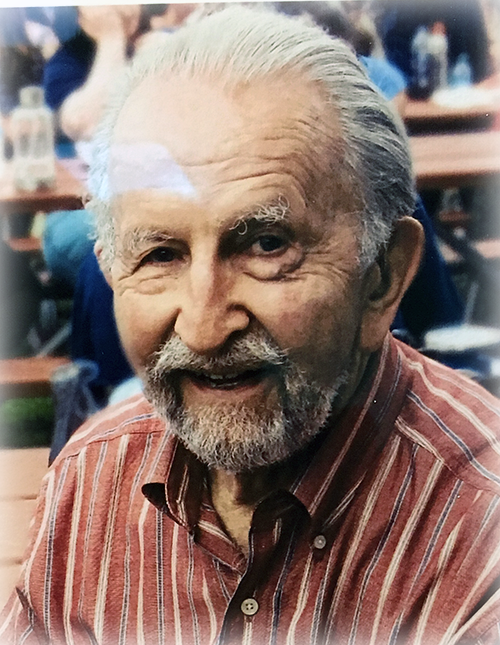Fred Olson Biography (click here)

Frederick Stanley Olson was born on April 4, 1930, in the town of New Ulm, Minnesota, a town of about 9,000 population at the time, of German heritage, named after the city of Ulm in Germany. Other than the emigrants from Ulm, most of the early pioneer settlers in the mid-19th century were of German-Bohemian descent, with farming backgrounds.
Fred’s early pioneer families were the Gags and the Forsters on his mother’s side, who settled in New Ulm around 1860. His father’s father, with his three brothers, all professional men of Norwegian descent, came from Milwaukee, Wisconsin to Minnesota in the late 1890’s, with three of them settling in other parts of southern Minnesota while his grandfather, Albert A. Olson, settled in New Ulm and became Vice-President of the town’s large Eagle Roller Mill. His father’s mother was of the Schaeffer families, who settled a farm northeast of New Ulm and were survivors of the last Sioux Uprising in 1862, known locally as the “Indian Massacre.” His father’s mother, Elizabeth Schaeffer, was born during these Indian wars and, because of the kindness of her father, who had fed the starving Sioux, they spared his farm while others around them were burned to the ground.
All the settlers in the path of the marauding Indian bands fled to the sanctuary of New Ulm, where the barricaded defenders were finally saved by a troop U.S. Calvary who came from the larger town of Mankato 30 miles away to rescue the besieged New Ulm. This was the final battle of the Sioux Nation, who were then sent to live on reservations in Minnesota and the Dakotas, Chief Sitting Bull among them.
Fred’s father, Stanley, was a pharmacist who, in partnership with his brother, Howard Olson, opened and ran for some 23 years a very successful drugstore (with a soda fountain) on Main Street in New Ulm. His mother, Beatrice, was a local artist of oil paintings, Norwegian rosemaling and sculpture, whose paintings of local scenes had been widely exhibited and now hang in many private homes in New Ulm.
Fred, upon receiving a Naval ROTC grant to attend the University of Minnesota to train as a U.S. Navy Midshipman, received both his B.A. degree in English literature and his commission as an Ensign in the U.S. Navy upon graduation in 1953. He served on active duty for five years, briefly during the Korean War and then several more years of sea duty with the Pacific Fleet, following which he served on the staff of the Sixth Fleet headquarters in Naples, Italy for two years, where he received his final promotion to Lieutenant Senior Grade.
After leaving active duty with the U.S. Navy in 1958, Fred spent another three years in the Naval Reserve, during which time he completed work for his M.A. degree in English Literature and Linguistics and completed course work on his PhD in Comparative Literature.
His teaching career lasted nearly thirty years. Early in his teaching career, he was awarded a Fulbright grant to teach in Japan. He taught the teaching of English to Japanese professors for two years at the University of Tottori. Later, following several years teaching at Western Washington University he returned to Japan to serve two years as Chairman of the English Department at the American International School in Tokyo. His two children, Jennifer and Matthew, were both born in Japan.
During his years of teaching at Shoreline Community College in Seattle, WA, he received a National Foundation for the Humanities grant to create and teach an interdisciplinary course in Science and the Humanities, which was later included in the curriculum offerings of both SCC and other institutions.
In addition to his work in education, Fred was an ardent photographer and, in the areas of fine arts, several of his portfolios (of the people and cultures of Japan, Ireland, Mexico, India and Nepal) were exhibited in galleries both in Seattle and on Whidbey Island between 1980 and 2008. Fred also worked in the area of professional photography, a member of the American Society of Magazine Photographers, specializing in travel photography with many of his color photographs appearing in various media, including advertising and textbook, encyclopedia and calendar illustrations. He prepared for publication a book featuring nearly 300 of his photographs, in both black and white and color, embracing his entire career with the photographic image.
His interest in sports led him, at the age of 50, to join his son in karate training, and he achieved the brown belt before a serious muscle injury brought this training to an end.
Fred and his wife, Carol, enjoyed sailing Puget Sound with his cruising sailboat and hiking the trails in the Cascades as well as cross country skiing in the valleys. Traveling was a frequent pleasure both in the States and abroad where they explored many countries and often revisited Hawaii and Wales, the whole of the British Isles and Ireland.
Fred and Carol, as members of the One Drop Zendo Association, were instrumental founders in establishing in 1995, in the Double Bluff area on Whidbey Island, WA, the Tahoma Zen Monastery, under the guidance of abbot, Shodo Harada Roshi (Zen master). This later gave rise to the Enso House hospice.
At about the same time, they together started the International Folk Dancers group, under the teaching of the professional Sonny Newman from the Mountaineers Club in Seattle. Dances were held weekly at the Bayview Hall for many years. Over a period of 14 years, Fred started three different book clubs in the Langley area, one of which, the Spiritual Classics Book Club, has been meeting since 2006, continuing now with name changed and purpose broadened.
Seeking an introductory renewal of their Christian roots, following many years in Zen Buddhism study, they along with another couple started the South Whidbey Unitarian-Universalist Congregation in the early 1990’s, and remained active for several years, meeting in various temporary quarters. The Congregation has now built a church, which stands in rural Freeland.
In the year 2000, Fred had a deep, transforming experience which caused him to embrace again the Roman Catholic faith of his youth. Bringing with him his many years of the meditative training and philosophical understanding of Zen Buddhism, he remained in his later years a devoted member of St. Hubert Catholic Church in Langley.
Fred had high family values and was a devoted husband, father and grandfather. He is survived by his wife, Carol, his daughter Jennifer of Seattle, his son Matthew and grandson Alexander of Seattle, three stepchildren, Stanley Case of Edmonds, Marguerite Case of Shoreline, and Charles Case of Swansea, Wales, U.K., and five step-grandchildren.
Fred’s funeral mass was offered on April 9th, 2015, and a reception followed at Langley United Methodist Church. Internment with Naval Military Honors was at Sunnyside Cemetery in Coupeville, overlooking the prairie.
If you wish to honor Fred with a tribute, please consider Enso House or a charity of your choosing.
[wp_books_gallery display=51 pagination=true]
